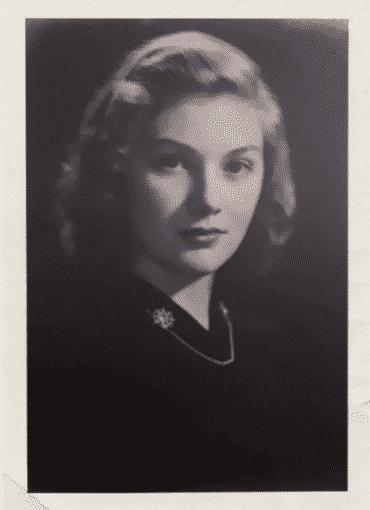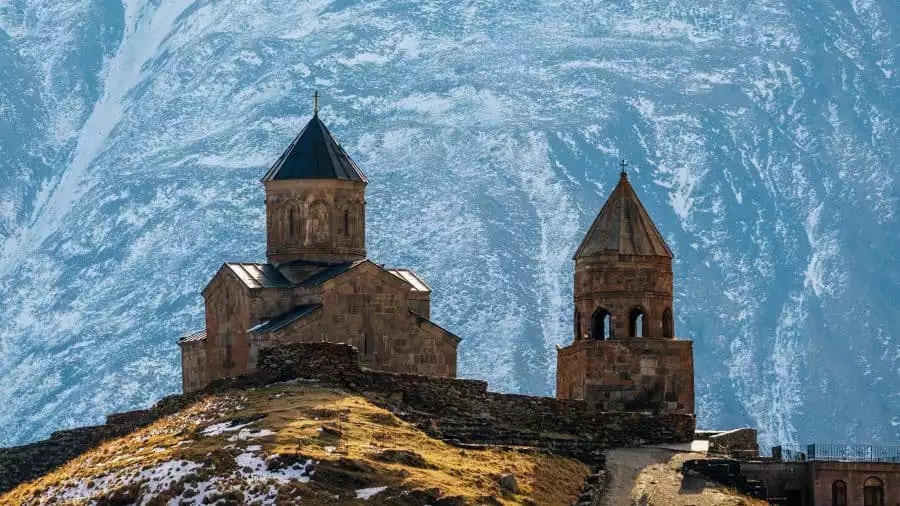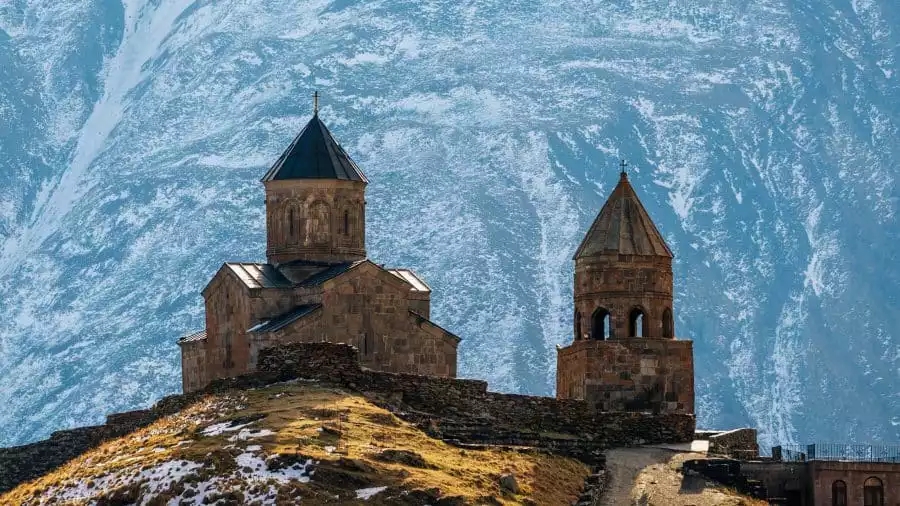The story of food is the story of culture – palatable journeys of spices and flavours tell the history of a region and its people. Even throughout shifts and migrations, these pillars of culinary identity carry on, permeated into the very essence of a nation.
Few better examples of this cultural continuity via food exist than the seismic global shifts of populations brought on by wars, famine and a changing modern landscape during the nineteenth and twentieth centuries. As millions left their historic homes in search of new opportunities, they carried their culinary traditions with them.
Among those that migrated were the inhabitants of the great kingdoms and empires of the old European guard – among them those of Italy, Germany, Spain, Poland, Russia, Georgia, Prussia.
Author, socialite and banker, David Gigauri hails from this long tradition of noble Georgian heritage. In the recent recipe book Be My Guest: The Georgian Recipe for Cooking Success, co-authored with Anna Saldadze, Gigauri regales in the history of his ancestral land and the cuisine that shapes its rich patrimony.
Be My Guest takes a rare view into the favourite recipes of some of Georgia’s most exceptional expatriates, along with their stories in their own words, thus casting an illuminating lens on an obscured, but historic, cuisine in its cultural context.
The recipes themselves are either authentically Georgian, improvised versions of the originals, or personal dedications to Georgians themselves (such as Lobster à la Bagration by the ‘King of Chefs and Chef of Kings,’ Marie-Antoine Antonin Carême).
Speaking from his London home Gigauri explains how the book came to be:
“… The event that became the genesis of the book, was precisely in a format that became the concept of the book – two Georgians abroad discussing food and drink. I was at the Hemingway Bar at the Ritz Paris visiting my future co-author Anna Saldadze, when a little trivia fact about the location kicked off a two-hour discussion…and led to a book.“
“As a passing comment, it was noted that at this precise bar, the Ritz cocktail-making legend Frank Meier created a drink for a socialite Georgian emigre Nicky Tumanishvili (called Nicky’s Fizz, made with gin and grapefruit, delicious!).
This triggered a conversation that took us across the globe and generations, from General Bagration defeating Napoleon (while having a lobster dish created in his name), to enigmatic muse of the Silver Age Salome Andronikashvili writing about making Chikhirtma soup in post-war London, to the stage of New-York City Ballet and its founder, the great gourmand George Balanchine.“

“Eighteen months after our rendezvous in Paris, the book was published as a collection of entertaining culinary stories and recipes from some of the biggest names of Georgian emigration. The bespoke visuals of the book give Georgian gastronomy a new look, and it’s now available in a smaller format (and in German too).“

Gigauri continues; “…this interest in the subject of Georgian diaspora throughout history was not new to me. Being a Georgian who always lived outside of Georgia, it created an inherent interest in my peers, especially that so many of my own family, by fate of history, were spread across the world…and as you would expect, not without a culinary tale!”.
To further give colour to the deep history behind the essence of the book, the author explores some of the landmark central figures of the Georgian diaspora via historic accounts, personal anecdotes and family history. As a taste for the book itself, DDW selects four excerpts from Gigauri’s most compelling characters and stories:
Artchil Gourielli-Tchkonia

Artchil escaped the revolution in 1920’s and ended up in France, while my side of the Gourielli (as they were known at time) family stayed behind. My great grandmother Ekaterine Gourielli ended up as a French teacher in the remote region of Svaneti after her husband was executed by the Bolsheviks.
Artchil was an avid bridge player and in Paris went to bridge parties at the home of Countess Marie-Blanche de Polignac. Unlike her withdrawn mother, fashion designer Jeanne Lanvin, the countess was a keen socialite. One evening in 1935, the American cosmetics queen Helena Rubinstein found herself sitting across the table from a big, handsome man in his forties, who was a warm, humorous and easy-going bon vivant. She had an excellent time in his company.
Although he played to win, as she did, he kept up a stream of amusing patter that made her laugh all through their game. She couldn’t remember the last time she had had such an enjoyable evening. She smiled even when he teased her about being a sore loser because she had got worked up about losing a few francs. As one of their evenings together drew to a close, Artchil suddenly departed from his usual light-hearted banter.

“Helena, would you do me the honour of having dinner with me tomorrow evening?” he asked her solemnly. “Tomorrow evening?” she echoed, dismayed. “I can’t — I’m leaving for New York!” Artchil took her hand and held it gently in his. She felt no insistence in his grasp, just undemanding affection and friendship.
“What’s your favourite restaurant in New York?” Artchil asked. “The Colony,” she replied. The restaurant was the watering hole of the rich and famous, the place to see and be seen in the Big Apple. Helena was a regular and had her own table.
“Fine,” he said. “Let’s make a reservation for the next time I’m in New York.” When they said goodbye, she couldn’t help trembling.
She was swept up in the whirl of business and social life as soon as she arrived in New York but that didn’t stop her heart beating faster when her secretary rang her one morning to say she had Artchil on the line, and did Helena want to take the call?
“Helena?” said the familiar tones when she picked up the phone. “It’s Artchil. You haven’t forgotten our date, I hope? I’m in New York. I’ve booked us a table for tonight at the Colony.” (extracts from Helena Rubinstein: The Woman who Invented Beauty, by Michèle Fitoussi)
When he asked for her hand in marriage he did it by the book (not my book). She and my great uncle Artchil were married in Baltimore in 1938. They later released a Gourielli cosmetics and perfume line to honour the name.

Tamara Bagration-Imeretinsky

This family story spans across several countries and generations. After the Western Georgian Kingdom of Imereti was annexed by the Russian Empire, Tamara’s family was not allowed to remain in the country and were forced into exile.
My side of the family managed to stay and thus we were separated. Fast forward to Tamara’s father Prince Michael Bagration-Imeretinsky, he was born in Russia, raised in Ukraine, educated in England, and resident in France. Somewhat similar path was followed by my immediate family and the current generation again ended up in the same place – this time in the UK.

Every summer the children and grandchildren of Princess Tamara Imeretinsky gather on Tresco, a small family-run island paradise in the Isles of Scilly, 28 miles south of Land’s End (most westerly point of mainland England).
Her eldest son Robert Dorrien-Smith runs the Tresco Estate, with its beautiful sub-tropical gardens, and white sandy beaches. Island-caught produce is plentiful, and Tamara remembers feeding the family with everything Tresco could supply: mackerel or pollock for breakfast, rabbit for lunch, pheasant for dinner.
Lobster and crab were everyone’s favourite treat, served cold with home-made mayonnaise, or hot with Thermidor sauce. Lobsters remain readily available on Tresco today, serving as the island’s logo, a welcoming symbol for the many visitors who come to stay on Tresco, or visit the Abbey Gardens.
Two animals firmly off the menu are the red squirrels and golden pheasants who run wild in the garden amidst the array of exotic plants from all over the world – the Mediterranean, South America, South Africa and Australasia. Wandering in the warm air amidst the palm trees it’s easy to imagine you might be in Imereti, not too far from the Black Sea.
Ilia Zdanevich

Known as Iliazd, he was a Futurist writer, artist, typographer, and book designer who moved to Paris in 1921. My side of the Gardapkhadze family remained behind in Georgia (our maternal grandparents). While still in the country, he was credited with discovering the art of the then unknown genius artist Pirosmani.
From 1922, Zdanevich designs fabrics, first in collaboration with Sonia Delaunay, then, from 1927 for Coco Chanel. Ilia Zdanevich was introduced to Chanel by Serge Diaghilev, and this meeting resulted in a long-lasting artistic collaboration and a close friendship. Initially he became the head of the graphic bureau of «TISSUS CHANEL», and eventually became the head of her textile production.
His most important artistic period came later with his livre d’artiste editions that made him famous all over the world. Graphic works for these editions were created in a collaboration with Pablo Picasso, Joan Miro, Marc Chagall, Max Ernst, Fernand Leger, Georges Braque, Alberto Giacometti, etc.

He was known to be a master of all trades and our family learnt that he would stick around in the kitchen while Mrs Zdanevich was preparing her famous pilaf, and would suddenly interrupt his own flow of conversation about painting or Georgian spelling to give her valuable culinary advice. Alas, neither the pilaf recipe nor his advice reached us, but anyone who has seen or read his work, can at least guess how this advice was delivered.
George Gigauri
My brother George is a senior humanitarian, serving as the Chief of Mission of the UN Migration Agency in Bangladesh. He previously served as the Chief of Mission in Papua New Guinea and held numerous posts in Asia and Europe.
Many moons ago, in a faraway world, there lived a creature named Bonono, a giant eel larger than a coconut tree that would roam the ocean, hunting sharks and swallowing fishermen who had the misfortune to cross his path.

This is a legend of the people of the tide in the Tulun Islands, who live at the top of an underwater volcano in the Solomon Sea, known to the Western world as the vanishing Carteret atolls of the Pacific Ocean. This is where George was heading to inspect some climate change adaptation project they started the previous year.
So they began their boat ride. They tested the sat phone and equipment; all seems to be in order but the crew still looked anxious. Two weeks ago a fishing boat with 10 people onboard went missing – many people have vanished on this journey. The skipper, a weathered man with a mouth red from chewing betel nut, and skin so dark that it shimmered blue, looked relaxed. One shouldn’t worry then.
The water is of such a shade of azure it looks like they are gliding on an icy desert. The giant white clouds are hanging so low, it feels like you can touch them, and their reflection on the water looks like submerged icebergs.

Far far away they saw pillars of rain that seem to unite some clouds and ocean, making them appear as trees growing out of the sea. Suddenly flying fish flit around the boat and a little later the skipper frantically points to the right … a huge splash and they catch a glimpse of a whale diving back under, as he blows a fountain into the air. The water extends into the horizon in every direction with no landmass in sight.
It was time to eat. Led by their skipper they got the line and the hook and started to fish. Within minutes, the water around the boat was swelling with fish, creating a flicker of colour in each ray of light. This in turn created a frenzy above the boat, with birds torpedoing the waters for easy prey. No one was going to go hungry that day.
Upon return to Port Moresby, his administrative assistant encountered a dilemma. Normally UN officials receive a per diem allowance to buy food when on a work trip, which is reduced if the food is provided by the host. She knocked on his door inquiring how to treat this situation, where neither of these two cases apply. They both agreed that the ‘host’ was treating them that day.
You can order the book “Be My Guest: The Georgian Recipe for Cooking Success” by David Gigauri and Anna Saldadze here
UP NEXT: PHILIP COLBERT DEFIES PANDEMIC WITH LOBSTERS AND ROBOTS




